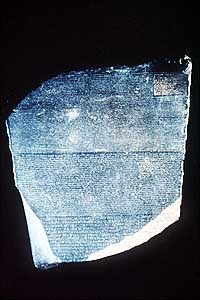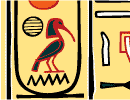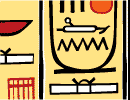The New York Times -- December 28, 1999
With New Finds, Egyptology
Flowers
By JOHN NOBLE WILFORD

Courtesy The British Museum, London
|
The Indispensable Rosetta
Stone
The object that allowed scientists to decipher
hieroglyphics was discovered 200 years ago. It set the field of
Egyptology in motion, and enthusiasm for the ancient
civilization has yet to subside. |
 wo centuries ago,
an engineer with Napoleon's army in Egypt snatched intellectual
triumph from the jaws of military defeat by discovering the Rosetta
Stone. This marked the start of scientific Egyptology, a field that,
more than ever, is bursting with discoveries and new ideas about one
of the most splendid and durable civilizations in the ancient world.
wo centuries ago,
an engineer with Napoleon's army in Egypt snatched intellectual
triumph from the jaws of military defeat by discovering the Rosetta
Stone. This marked the start of scientific Egyptology, a field that,
more than ever, is bursting with discoveries and new ideas about one
of the most splendid and durable civilizations in the ancient world.
Napoleon had landed in the Nile delta the year before, 1798, with
plans to seize Egypt and disrupt the overland link in Britain's vital
trade route to India. "Soldiers, 40 centuries are looking down on
you," Napoleon reminded his troops before leading them to battle
within sight of the pyramids of Giza. His army prevailed over the
Egyptians, but 10 days later, the French fleet was destroyed by Adm.
Horatio Nelson, ending Bonaparte's dream of further conquest.
Of surpassing importance to the scholarship of antiquity, however,
Napoleon brought with him a corps of some 150 scientists, geographers
and linguists from among the best minds of France, an expression of
the Enlightenment in the midst of imperial adventurism. Over several
decades, they described and classified all they learned from the ruins
of ancient Egypt, including the especially rewarding Rosetta Stone.
Inscriptions on the slab of dark basalt found in the summer of 1799
at the site of ancient Rosetta, near Alexandria, were the key to
deciphering hieroglyphics, the formal and ceremonial language of the
pharaohs. Scholars could then read the writings on the walls of tombs
and temples and on the rolls of moldering papyrus. Opened to them for
the first time was more than 3,000 years of the history and religion
behind the monumental ruins along the Nile.
"Two hundred years later, we can read ancient Egyptian almost as
well as any other foreign language," said Dr. James P. Allen, a
curator of Egyptian art and specialist in the culture's language and
religion at the Metropolitan Museum of Art in New York City.
Perhaps no other branch of archaeology has fascinated the general
public longer and deeper. Tourists flock to the massive pyramids
outside Cairo and the temple ruins of Thebes up the Nile. At museums
people stand in awe before the graceful form of Nefertiti and all the
mummies carefully prepared long ago for the afterlife.
Two major new exhibitions of Egyptian art and artifacts, at the
Metropolitan Museum and the Museum of Fine Arts in Boston, are drawing
large crowds.
After a thorough cleaning, the Rosetta Stone itself went back on
display last summer at the British Museum. True to the axiom of
warfare that to the victor goes the spoils, the jewel of the French
campaign in Egypt ended up in London.
What is even more remarkable, scholars say, the prodigious
explorations of the last two centuries have only whetted public and
professional appetites, making Egyptology one of the most robust
endeavors of archaeologists. New discoveries have pushed back the
beginnings of Egyptian history. New interpretations of earlier
findings have refined thinking about the lives of pharaohs and their
subjects, the origins and richness of the language and the philosophy
of life and death that inspired the pyramids. Yet mysteries abound,
driving further searches among the ruins.
"It's a growth field," said Dr. Emily Teeter, a curator of
Egyptology at the Oriental Institute of the University of Chicago.
"Each year there are probably four or five very significant
discoveries. And there's so much material that has been excavated in
the past but has not been studied."
This year has been
especially rich in discoveries:
• In the desert west of the Nile, between Thebes and Abydos,
archaeologists from Yale found inscriptions that they say are the
earliest known examples of alphabetic writing. Dated to somewhere
between 1900 and 1800 B.C., two or three centuries earlier than
previously recognized examples of uses of an alphabet, the writing is
in a Semitic script with Egyptian influences.
• In the ruins of a 3,700-year-old town near Abydos, excavators
from the University of Pennsylvania uncovered a mayor's mansion. Its
grandeur suggested that at the time mayors enjoyed significant
affluence and political power, in some cases as much as a reigning
pharaoh, and may also have supervised religious activities.
• In the silt of Alexandria harbor, French underwater
archaeologists found numerous fallen stone columns, statues, sphinxes
and masonry blocks with hieroglyphic and Greek inscriptions. Judging
by the location, archaeologists said these could be remains of
Cleopatra's palace in the last century B.C. Her suicide, immortalized
by Shakespeare, was a dramatic stroke in transforming a declining
Egypt into a province of the Roman Empire.
• In another exploration into the Roman period, Egyptian
archaeologists made what they said was one of the most spectacular
discoveries in recent decades. At the Bahariya oasis 230 miles
southwest of Cairo, they found a cemetery of buried tombs extending
over two square miles. In the first four tombs examined, they counted
105 mummies decorated with elaborate masks and waistcoats covered in
gold. As many as 10,000 mummies may yet be uncovered in the place
archaeologists are calling the Valley of the Golden Mummies.
All the while, Dr. Kent R. Weeks of the American University of
Cairo continued exploring the dark interior of the huge tomb for most
of the 52 sons of Ramses II, one of the most powerful pharaohs who
reigned in the 13th century B.C. At the time of its discovery in 1995
in the Valley of the Kings, the tomb was hailed as the greatest royal
find since Howard Carter in 1922 came upon the treasures of
Tutankhamen, the young King Tut.
Dr. Mark Lehner of the University of Chicago kept digging in the
quarters inhabited by workers who built the pyramids at Giza, which
are the last survivors of the so-called seven wonders of the ancient
world. "For those who claim spacemen built the pyramids, we can point
to these workers' villages," Dr. Teeter said.
Dr. Barry Kemp of Cambridge University in England excavated more
sections of Amarna, site of the capital of Akhenaten and Nefertiti in
the 14th century B.C., a revolutionary interlude for Egyptian
sculpture and religion.
At Abydos, 250 miles south of Cairo, Dr. Gunter Dreyer, director of
the German Archaeological Institute in Egypt, continued research that
uncovered evidence of Egyptian kings preceding by two or three
centuries the usual date, 3000 B.C., for the start of the early
dynastic period. A year ago, he reported finding hieroglyphic
inscriptions on pots and bone that were made as early as 3200 B.C.,
possibly 3400. Although controversial, the inscriptions suggested that
writing first appeared in Egypt, not in Mesopotamia, the valley of the
Tigris and Euphrates Rivers in what is now Iraq.
"The scale of individual excavations today is small, compared to
the early expeditions, but the number is larger than ever before,"
said Dr. Rita E. Freed, curator of ancient Egyptian and Near Eastern
art at the Museum of Art in Boston.
"The reason to excavate now is not so much to find beautiful museum
pieces but to answer questions, and they're different questions
compared to those of early generations," she said. "They are more
about the institutions surrounding the temples, and how the people
lived. We know about pharaohs but not a whole lot about what you might
call the man in the street."
The Metropolitan Museum's current exhibition, "Egyptian Art in the
Age of the Pyramids," covers a period of some 500 years, from about
2650 B.C. to 2150 B.C., which ranks as one of the world's most
creative epochs. For reasons still not clearly understood, rulers of
the Old Kingdom, as the period is called, forged a powerful state and
brought people of diverse regions together through a shared national
consciousness. They left a stunning physical legacy in the pyramids,
the enigmatic Sphinx and statues and other works of art that would
define Egyptian culture for centuries to come.
"Egyptians were probably the first to be aware of the nobility
inherent in the human form and to express it in art," Heinrich
Schäfer, a German art historian, wrote in 1919.
Strolling through the gallery at the Metropolitan, Dr. Allen came
to an almost life-size statue of Sepa, a man wearing a kilt and
holding a staff. It is one of the earliest known examples of large
Egyptian nonroyal statuary and evocative of what was happening in this
creative period. "This is Egypt emerging from a two-dimensional
background, all flat and obscure, into something that stands out in
three dimensions," Dr. Allen said.
A significant shift in understanding ancient Egypt began about 50
years ago, Dr. Allen said, with new interpretations of ancient texts
by Henri Frankfort and John Wilson of the University of Chicago. Until
then, scholars tended to see everything with Western eyes, often
concentrating on what Egypt could tell them about the Bible. A deeper
understanding of the nuances of the texts has given scholars a more
Egyptian view of the culture.
In previous translations, for example, the word "ka" was thought to
mean soul or spirit, which has strong Western theological
connotations. Now it is understood, Dr. Allen said, to mean "life
force" or "life energy," the difference between the living and the
dead. Scholars think these and other interpretive changes are giving
them a truer understanding of the Egyptian concept of the afterlife
and the metaphorical writings about creation and the cosmos, a way of
explaining how everything came from a single source that in some way
resembles the Big Bang.
The exhibition at the Boston museum, "Pharaohs of the Sun:
Akhenaten, Nefertiti, Tutankhamen," concentrates on another period of
political change and artistic creativity. In the 14th century B.C.,
the pharaoh who became known as Akhenaten assumed the throne and broke
with past ideologies, notably the religion of many gods. Shrines and
other evidence indicate that most of the people in their homes
continued to worship their several gods, but in official art, the only
god depicted was Aten, and in the temples, the liturgy included "The
Great Hymn to Aten."
Whether Akhenaten was the world's first monotheist is still
debated, Dr. Freed said, but it was clear that he tried to change
Egyptian religion to a belief in one god who was an all-powerful
creator. This god was worshiped through the pharaoh and his chief
wife, Nefertiti, who seemed to share her husband's power. The reforms
of Akhenaten's 17-year reign came to an end during the time of
Tutankhamen, and Egypt returned to most of its old ways.
In the exhibition catalog, Dr. Freed observed, referring to the
seat of Akhenaten's reign, "In many respects, Amarna is still with us
today: in the concept of a single god, man's intimacy with his deity,
naturalistic expression in art, and the ability of a single individual
to dramatically influence the lives of so many."
The many unanswered questions and the expectations of new
discoveries may drive archaeologists, but why the unending popular
fascination with ancient Egypt, ever since the discovery of the
Rosetta Stone?
Perhaps it is the mummies. "Most of us got interested in Egypt at a
young age by being taken to museums to see the mummies," Dr. Freed
said. "Young children discover mummies at the time they are beginning
to comprehend death."
Or perhaps it was the civilization's grandeur and gold, its romance
and intrigue, its imperial ambitions and vaulting hubris. "For a lot
of people," Dr. Allen said, "the big fascination about ancient Egypt
is the amazement of discovering how some of their thought processes
were so very much like those with which we are familiar today."
The grand architecture surely is a factor. Unlike the rival
Sumerians and Assyrians, who had little stone to work with, the
pharaohs commanded the erection of awesome temples and tombs meant to
last the eternity of their anticipated afterlives. The Great Pyramid
of Khufu, which overshadowed Napoleon's troops, rose 482 feet and was
the world's tallest structure until the Eiffel Tower, completed in
1889.
"We as modern people believe in progress, of things getting better
and more sophisticated as time moves forward," Dr. Teeter said. "So
it's with a sense of awe and curiosity that we think about why and how
people in antiquity built such things so long ago without the tools we
have. We wonder if the Egyptians had some knowledge lost to us today."





